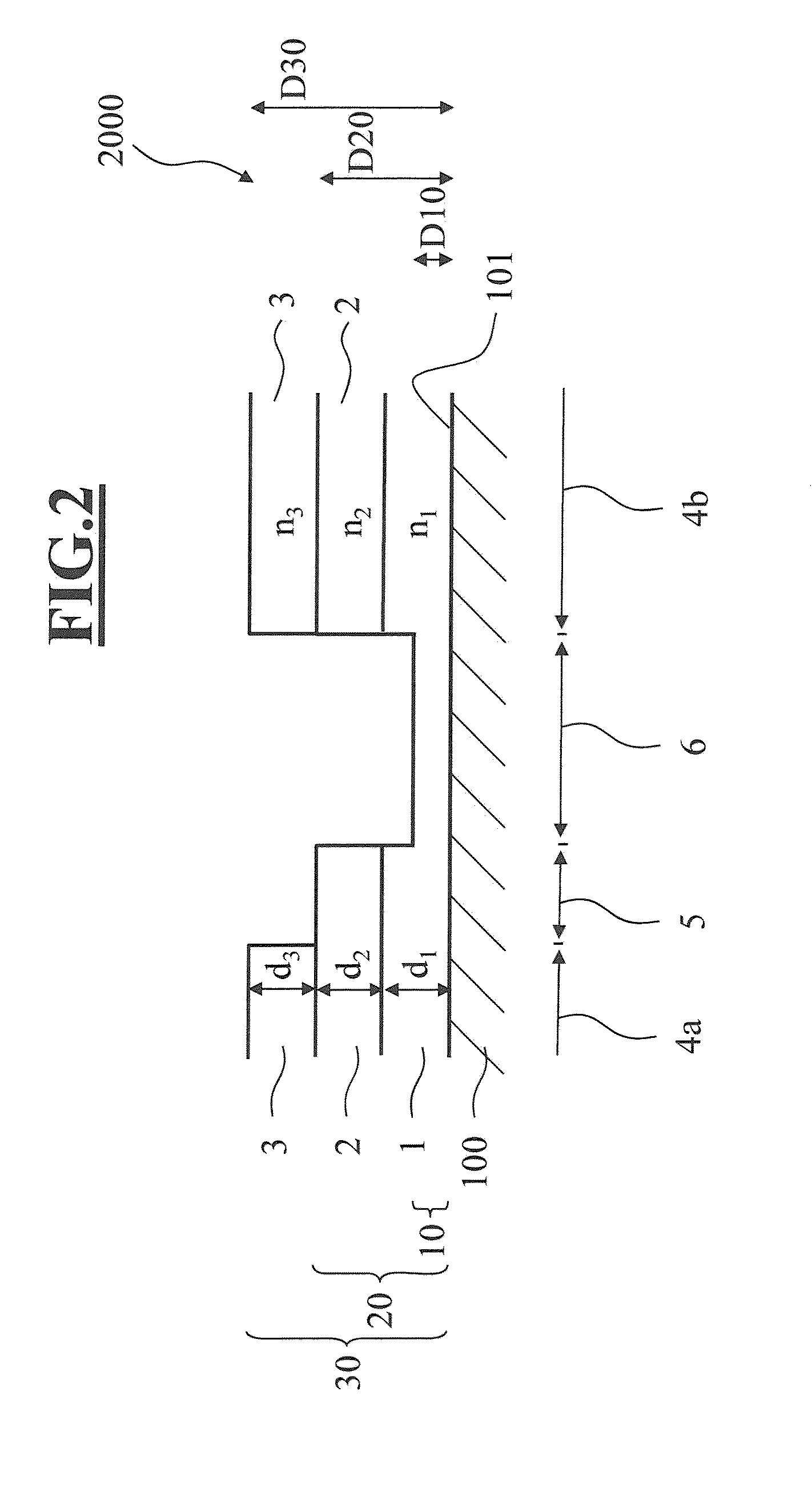Spectacle lens and method and apparatus for making the same
a technology of spectacle lens and lens body, applied in the direction of electron beam welding apparatus, applications, instruments, etc., can solve the problems of depressions that could practically no longer be recognized, can only be registered by machines insufficient ways, etc., and achieve low removal rate, high removal rate, low removal rate
- Summary
- Abstract
- Description
- Claims
- Application Information
AI Technical Summary
Benefits of technology
Problems solved by technology
Method used
Image
Examples
first embodiment
[0064]FIG. 1 shows a detail from a cross section through a spectacle lens 1000 according to the invention with lens body 100 and interference layer system according to a The lens body 100 has a light-refracting effect.
[0065]An interference layer system is applied on the surface 101 of the lens body 100. The interference layer system, in a first surface region 6, consists of a single thin layer 1 having a thickness d1. This thin layer 1 consists of a material having a refractive index n1. The first layer stack 10 in this first surface region 6 therefore has a first stack thickness D10 corresponding to the layer thickness d1 of the thin layer 1.
[0066]The interference layer system, in a second surface region 5, consists of two thin layers, namely the thin layer 1 having the thickness d1 and a thin layer 2 having a thickness d2. The thin layer 2 consists of a material having a refractive index n2. The second layer stack 20 in this second surface region 5 therefore has a second stack th...
third embodiment
[0075]FIG. 3 shows a detail from a cross section through a spectacle lens 3000 according to the invention with lens body 100 and interference layer system according to a
[0076]An interference layer system is applied on the surface 101 of the lens body 100.
[0077]As in the preceding embodiment, the interference layer system, in the two third surface regions (4a, 4b) of identical type, consists of three thin layers, namely a thin layer 1 having a thickness d1, a thin layer 2 having a thickness d2 and a thin layer 3 having a thickness d3. The thin layer 1 consists of a material having a refractive index n1. The thin layer 2 consists of a material having a refractive index n2. The thin layer 3 consists of a material having a refractive index n3. The third layer stack 30 in these third surface regions (4a, 4b) therefore has a third stack thickness D30 corresponding to the sum of the layer thicknesses d1, d2 and d3 of the thin layers 1, 2 and 3. The refractive indices n1 and n2, and n2 and ...
fourth embodiment
[0082]FIG. 4 shows a detail from a cross section through a spectacle lens 4000 according to the invention with lens body 100 and interference layer system according to a
[0083]As in the previous embodiments, an interference layer system is applied on the surface 101 of the lens body 100.
[0084]The interference layer system constitutes a related variant with respect to the embodiments according to FIGS. 1 and 3. The interference layer system, in the two third surface regions (4a, 4b) of identical type, consists of four thin layers, namely a thin layer 1 having a thickness d1, a thin layer 2 having a thickness d2, a thin layer 3 having a thickness d3 and a thin layer 7 having a thickness d7. The thin layer 1 consists of a material having a refractive index n1. The thin layer 2 consists of a material having a refractive index n2. The thin layer 3 consists of a material having a refractive index n3. The thin layer 7 consists of a material having a refractive index n7. The third layer stac...
PUM
| Property | Measurement | Unit |
|---|---|---|
| Time | aaaaa | aaaaa |
| Thickness | aaaaa | aaaaa |
| Color | aaaaa | aaaaa |
Abstract
Description
Claims
Application Information
 Login to View More
Login to View More - R&D
- Intellectual Property
- Life Sciences
- Materials
- Tech Scout
- Unparalleled Data Quality
- Higher Quality Content
- 60% Fewer Hallucinations
Browse by: Latest US Patents, China's latest patents, Technical Efficacy Thesaurus, Application Domain, Technology Topic, Popular Technical Reports.
© 2025 PatSnap. All rights reserved.Legal|Privacy policy|Modern Slavery Act Transparency Statement|Sitemap|About US| Contact US: help@patsnap.com



